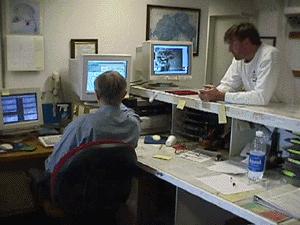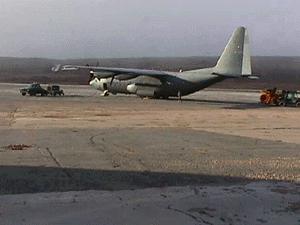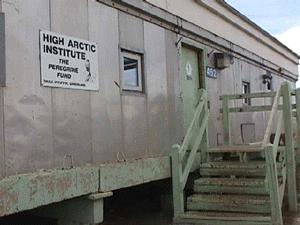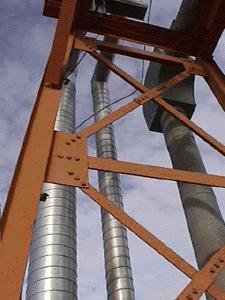23 August, 1999
Aloha from Greenland, Today Kevin and I went to the weather station at the
base where Jack works. He is on 12-hour shifts for the next three weeks
while the Canadians are here doing their transport. He inputs the weather
data to a computer system that makes it available worldwide and gives
individual information to the pilots for their flight plans. His office has
three different monitors. One is for a print out from the instruments on
Thule, which give such parameters as wind speed and direction, temperature,
pressure, and dew point at different stations. They also send up two
weather balloons daily to check for upper atmospheric conditions. The
second is a read out from a NASA satellite in a Polar orbit. It gives
visible light and infrared pictures of Greenland, which show the cloud
cover in different detail. The third is a topographic map of the pressure
system at 1800 feet. The information comes from different weather stations
around the world and is compiled by the Canadian Meteorological Center. He
is quite busy during these operations because there are so many flights
leaving and coming, approximately one an hour.
Kevin is anxious to get some long range weather data over the last 20
years that Thule compiled. He hopes to use this to determine the seasonal
variations and determine whether this correlates with yearly char
migrations to sea.
We were visited by the Danish Police Inspector and told that our permit
hadn't been officially honored at this point and that we would have to
leave on the next flight which would be on Wednesday morning. We decided
that that was the final word for this year and that we should see about our
equipment and make arrangements for flying home. We are disappointed, but
hopeful that the process will go forward and that next year we will have
everything in place. The area seems to be very promising for the
experiments and the project would be very doable especially in the nice
weather we have been having lately. Jack forecast that we would see sleet
tomorrow, but it is hard to believe.

Kevin and Jack at the weather station.

One of the many planes that land here. This one is called a Herc, short for Hercules. It has large tires enabling it to land on uneven surfaces. It can also be fitted with skis.

Our home at the Peregrine Foundation barracks.

These pipes carry hot water, cold water, and sewerage. They are all above ground, so they do not melt the permafrost. These parcticular pipes are bridging up over the road way.

Contact the TEA in the field at
.
If you cannot connect through your browser, copy the
TEA's e-mail address in the "To:" line of
your favorite e-mail package.
|
